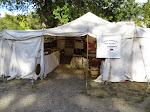In the Victorian age, water was so precious that bath water typically was re-used. In this case, as in many others, rank had its priviledge. The father of the family bathed first, then the mother, then the kids in descending age. I imagine that the bathwater at the end was quite disgusting.
I have tried to find information on towels of the era. If I am going to live the experience, I want to do it right. According to "The Workwoman's Guide" published in 1838, each family should have six to twelve towels for each wash stand. The "best fine towels" were made of the finest pinafore diaper (?), and measured 3 feet x 12 nails (27 inches). The "best coarse towels" were made of fine huckaback (huck towels) and measured the same as the best fine towels. These types of towels are still sold today. "Family coarse towels" were made of coarser huckaback and measured 1 yard by 11 nails (24.75 inches) while "Servants towels" were made of coarse huckaback and measured the same.1 The 1897 Sears and Roebuck catalog advertises damask (satin and linen) and turkish towels. They also advertise "Turkish Face Cloths" Size 15 x 15 (inches?), full bleached, plain white or with stripe. They were 5 cents each or 56 cents a dozen. Fancy patterned face cloths were also available.2
It is quite a shock to get into a cold bath. We took our own water to the last event in jugs. The temperature was well over 100 degrees every day. The water was so warm that we actually had to cool it off by adding ice water from the cooler!
My tub looks very similar to one pictured on the Smithsonian website, identified as an 1860 Sitz Bathtub.3
Mine looks to be made of galvanized metal, so it is probably newer. After filling it with 2-3 buckets of water, you sit in it and your legs dangle over the edge and rest on the ground. Needless to say, bathing the lower extremities is definitely a challenge.
Another method of bathing is simply washing up with a basin. This is much more portable than the bathtub, but not nearly as nice.
1 “The Workwoman’s Guide” by a lady. Originally published: London: Simpkin, Marshall, 1838.
21897 Sears Roebuck Catalog, Editor Fred L. Israel. Chelsea House Publishers, 1968. New York.
3 National Museum of American History. http://americanhistory.si.edu/collections/object.cfm?key=35&gkey=203&objkey=8825




Great post, Kim! Here is one source for diaper: http://www.wmboothdraper.com/Hemps/hemps_index.htm
ReplyDelete